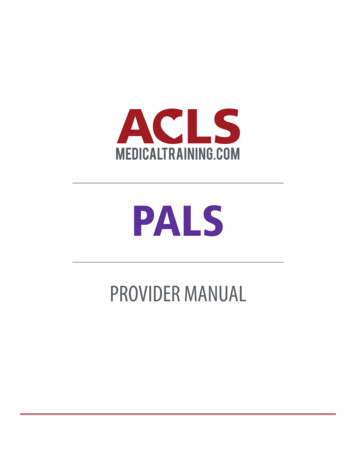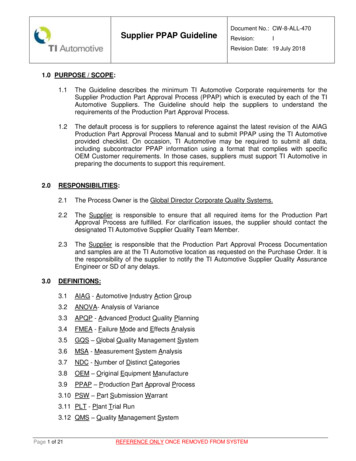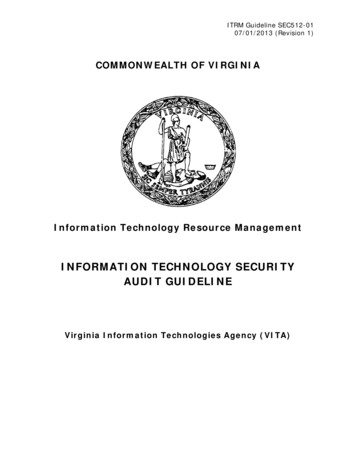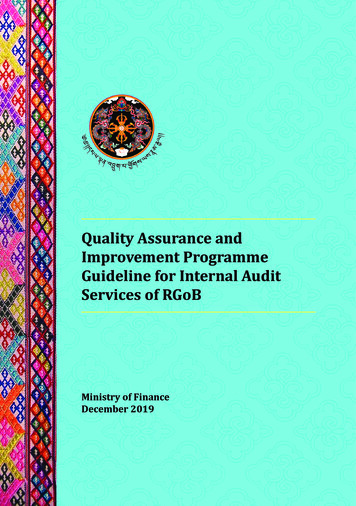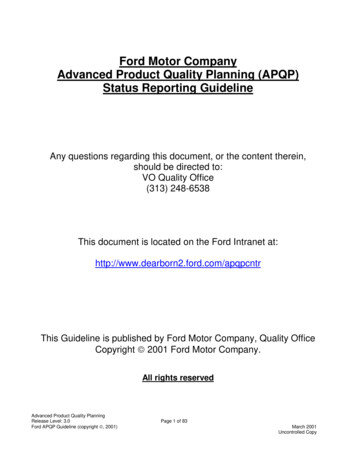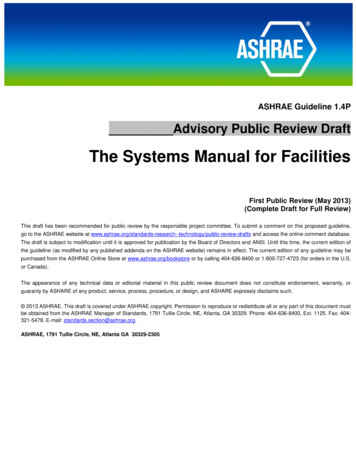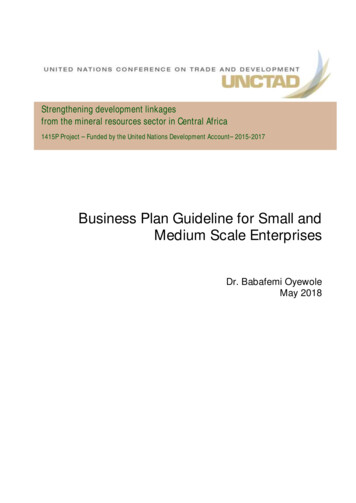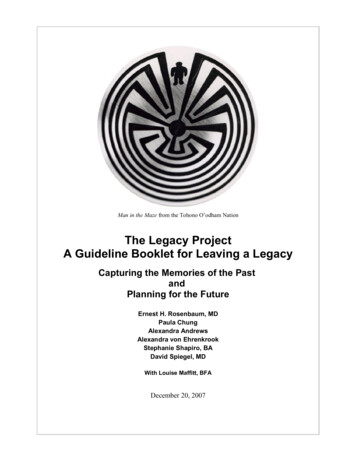
Transcription
Man in the Maze from the Tohono O’odham NationThe Legacy ProjectA Guideline Booklet for Leaving a LegacyCapturing the Memories of the PastandPlanning for the FutureErnest H. Rosenbaum, MDPaula ChungAlexandra AndrewsAlexandra von EhrenkrookStephanie Shapiro, BADavid Spiegel, MDWith Louise Maffitt, BFADecember 20, 2007
Cover image: Man in the Maze from the Tohono O’odham Nation of southern Arizona.The figure represents an individual’s path through life, with its many twists and turns inwhich he gains wisdom and knowledge. Before approaching death, he reflects on thewisdom he has gained and then, in harmony with the world, he accepts his fate.
DedicationWe wish to acknowledge three survivors whose legacies have made a difference tosociety by improving quality of life.Ken Colvin, a cancer survivor who, as a 19-year-old Army surgical technicianhelped liberate Nazi death camps in 1945. He later supported student fellowships andmany charities, and set an example for how to give back and live.Annette Campbell-White, a valiant cancer survivor, has become a philanthropicexecutive to promote medical research projects and is a major supporter of the Arts,Music and Culture in California and in her native New Zealand, making a difference inmany people’s lives.William Lowenberg, the sole member of his family to survive Auschwitz andDachau, became a major financier and community activist, supporting and promotingmedical, cultural, and social projects and serving on many charity boards.John Kerner, MD, a survivor of World War II who led his medical corps teamthrough D-day, Omaha Beach, France, and the Battle of the Bulge. All of his medicalcorps team survived. In November 2007 he received the French Legion of Honor Medalfrom the President of France.
Table of ContentsSummary of the Legacy Project . 1The Goals of the Legacy Project . 2Elements of the Legacy Project .3Thoughts About the Future .6Legacy Lessons of Symbolic Immortality .6Concepts of the Legacy Project . .10Conclusion .10Appendix A: Potential Topics for an Ethical Will . .11Appendix B: The Family History Initiative of the U.S. Surgeon General 12Appendix C: A Personal, Portable Health Record 16Appendix D: Creating Your Family Tree .17Appendix E: Scrapbooking 19Appendix F: Conducting a Legacy Project Interview . . 20Appendix G: Planning for Your Future by Getting Your Affairs in Order .23Appendix H: Additional Resources .32
Summary of the Legacy ProjectThis booklet is a guide to help you create a life legacy for family and friends. This lifelegacy project will help you bring together your family's history, preserving the memoriesand events that represent your own and your family's life story. It is a way to pass onyour thoughts, your values, and your jokes, as well as your knowledge of the events thatshaped your ancestors’ lives and your hopes for the future.A legacy is a gift from one generation to the next.This booklet provides descriptions of the various elements that can be included in yourlife legacy. The appendices provide extensive details on methods and tools that can beused to create and preserve your legacy.Elements of the Legacy ProjectEthical Will: a personal, written and/or dictated record of your family stories,philosophic thoughts, values, and goals.Family Tree: an organized outline of family members and ancestors showing marriages,children, births and deaths with photographs where available. Includingmedical history of your ancestors and family members provides valuablehereditary information which can help provide potential future guidance forprevention of illnesses.Family History Recording: written, audio, or video recordings of stories and memoriesof past and current generations. These can be collected individually and/orat family gatherings.Scrapbooks: albums with pictures, literature, documents, and articles about the familyhistory and important events.Legacy of Love: documentation of clear decisions and planned social, legal, financial,and end-of-life arrangements.The goal of the legacy project is to help enable individuals and families to come to aclearer understanding of the meaning of their life history, love, and interrelationships, andto capture the memories of the past in a concrete way that satisfies the human need forsymbolic immortality.The term "symbolic immortality" refers to what remains from our lives after death. Mosthumans hope for some form of future immortality for their philosophy, their deeds andtheir souls. This project grew out of the Life Tapes Project working with cancer patientsand their families in which we found that for some families the sharing of family historyand philosophies became a turning point in their lives, affording them the chance toidentify and understand their legacy to their family and, if necessary, make life changesto clarify relationships.This booklet contains detailed information and directions on how to accomplish many ofthe tasks necessary to complete a comprehensive personal and family legacy.1
The Legacy ProjectCapturing the Memories of the Past and Planning for the FutureA legacy is a gift from one generation to the next. The Legacy Project provides astructured way to collect, save, and store a family tree with historical information andstories, photographs, audio and video recordings, articles, and documents of significantlife events and achievements. This can be a practical way of “capturing” a family’shistory and making a family legacy of many of the memories and precious events whichrepresent a person’s and a family’s life story.The project also provides guidance on how to plan end-of-life care, personal and financialaffairs, and help simplify necessary family duties and vital decisions.The Goals of the Legacy ProjectThe goals of the legacy project are to enable a family to come to a clearer understandingof the meaning of their life history, love and interrelationships, and to create a record thatwill hopefully exemplify the significance of the family’s life story. Personal interviewsvia audio and video camera recordings (transferred to CDs or DVDs) create a permanentlife record of memories that can have great significance for future generations.Over the last twenty years, there has been a growing interest in recording family historiesand family trees. Computer programs are now available which can help organize a familytree and history (e.g., Ancestry.com, Familytreemaker.com, familytree.com).Sometimes, a family history is documented because of family pride or interest in seekinginformation on where ancestors came from, their occupations, and how they lived. Othertimes it is done to obtain genetic or medical information which can be of vital value forfamily descendants.We started the Life Tape Project in the early 1970s initially making audiotapes and, later,video recordings, CDs and DVDs of cancer patients and their families to record theirmemories and thoughts, family history and stories, philosophy of life, wishes, goals,legacy, and family medical information.The Life Tape Project helped us appreciate the importance of family histories and stories.As the project progressed, we found that for some families the sharing of family historyand philosophies became a turning point in their lives despite the fact that the interviewwas only 1½-2 hours. This gave patients the opportunity to reassess their personalphilosophies and goals as they talked about their lives, affording them the chance toidentify and understand their legacy to their family and, if necessary, make life changesto clarify relationships.2
Elements of the Legacy Project1. Creation of an Ethical Will, which is a personal, written or dictated record ofyour and your family’s stories, life philosophy, legacy, and goals. Ethical willsare a way to share your values, achievements, blessings, life lessons, hopes anddreams for the future, love, and forgiveness with your family, friends, andcommunity.Ethical wills are not new. Initially, ethical wills were transmitted orally.Over time, they evolved into written documents.The Hebrew Bible first described ethical wills 3000 years ago (GenesisCh. 49). References to this tradition are also found in the Christian Bible(John Ch. 15-18) and in other cultures. Written for succeedinggenerations, the ethical will offers an opportunity to add to personal familyknowledge and history to express one’s life accomplishments, values, andlegacy wishes for the family.An 'ethical will' is not considered a legal document as compared to a‘living will' or ‘last will and testament' which are legal documents.Examples of categories for Ethical Will: Your personal philosophy Family Country Religious philosophy Thoughts about hope and the future Thoughts about your family legacyFor a suggested list of Ethical Will topics, see Appendix A.2. Creation of a Family Tree with pictures of family members. An organizedfamily tree provides a basic family history outline that can help prompt memoriesof early years, ancestors, and family stories. This has been made easier with theuse of personal computers, the Internet, and commercial genealogy programs.A diagram of a family tree is illustrated below followed by an example of thebasic types of information to record. Your family’s experience may includeadditional events, history and information that you want to include, such as datesof marriage or immigration from one country to another.3
Sample Family motherName:Date of Birth:Place of Birth:Date of Death:Notable Medical Conditions:Name:Date of Birth:Place of Birth:Date of Death:Notable Medical Conditions:Name:Date of Birth:Place of Birth:Date of Death:Notable Medical Conditions:Name:Date of Birth:Place of Birth:Date of Death:Notable Medical Conditions:Name:Date of Birth:Place of Birth:Date of Death:Notable Medical Conditions:Name:Date of Birth:Place of Birth:Date of Death:Notable Medical Conditions:Name:Date of Birth:Place of Birth:Date of Death:Notable Medical Conditions:Name:Date of Birth:Place of Birth:Date of Death:Notable Medical Conditions:SiblingName:Date of Birth:Place of Birth:Date of Death:Notable MedicalConditions:SiblingName:Date of Birth:Place of Birth:Date of Death:Notable MedicalConditions:MotherFatherName:Date of Birth:Place of Birth:Date of Death:Notable Medical Conditions:Name:Date of Birth:Place of Birth:Date of Death:Notable Medical Conditions:SiblingName:Date of Birth:Place of Birth:Date of Death:Notable MedicalConditions:SiblingName:Date of Birth:Place of Birth:Date of Death:Notable MedicalConditions:SiblingName:Date of Birth:Place of Birth:Date of Death:Notable MedicalConditions:SiblingSiblingName:Date of Birth:Place of Birth:Date of Death:Notable MedicalConditions:Name:Date of Birth:Place of Birt h:Date of Death:Notable MedicalConditions:MotherFatherName:Date of Birth:Place of Birth:Date of Death:Notable Medical Conditions:Name:Date of Birth:Place of Birth:Date of Death:Notable Medical Conditions:SiblingName:Date of Birth:Place of Birt h:Date of Death:Notable MedicalConditions:Your SpouseYouName:Date of Birth:Place of Birth:Date of Death:Notable Medical Conditions:Name:Date of Birth:Place of Birth:Date of Death:Notable Medical Conditions:ChildChildChildChildName:Date of Birth:Place of Birth:Date of Death:Notable Medical Conditions:Name:Date of Birth:Place of Birth:Date of Death:Notable Medical Conditions:Name:Date of Birth:Place of Birth:Date of Death:Notable Medical Conditions:Name:Date of Birth:Place of Birth:Date of Death:Notable Medical Conditions:Maternal GrandmotherSiblingName:Date of Birth:Place of Birth:Date of Death:Notable MedicalConditions:SiblingName:Date of Birth:Place of Birth:Date of Death:Notable MedicalConditions:SiblingName:Date of Birth:Place of Birth:Date of Death:Notable MedicalConditions:SiblingName:Date of Birth:Place of Birth:Date of Death:Notable MedicalConditions:Maternal GrandfatherName:Date of Birth:Place of Birth:Date of Death:Place of Death:Notable e:Date of Birth:Place of Birth:Date of Death:Place of Death:Notable r MotherName:Date of Birth:Place of Birth:Date of Death:Place of Death:Notable MedicalSignificantMedicalConditions:Conditions:By including any medical history that you know for ancestors and familymembers, you provide very valuable familial hereditary information and potentialfuture guidance for prevention of medical illnesses (such as heart disease, stroke,diabetes, obesity, osteoporosis and cancer) and/or help make a geneticreconstruction of your family’s heredity. In collaboration with other healthagencies, the U.S. Surgeon General has created the Family Health Initiative toprovide tools for families to enter and organize their family’s health history toshare with their physicians. Appendix B contains details about this program,website information, and a copy of the Surgeon General’s Family Health Portraitforms.3. Appendix C Information on Family Tree construction is available.4. Appendix D contains information on creating and maintaining your ownelectronic medical history record in a portable format to share with your doctors.5. Record the Family History with stories and examples of past and current4
generations using the family tree as a guide (instructions for the Legacy Tapeinterview are available in Appendix F). Family stories can be linked to variouspersons on the tree, describing their relationship to the storytellers and the family.A guide sheet is provided so the family history interviews can follow a similarpattern, including, for example, name, age, relationship, birthplace, marriage(wife or husband or partner), birthday, where they lived, list of parents,grandparents and children and stories about each.The Hallmark greeting card company, in collaboration with Marcia Cross, hasdeveloped an inexpensive easy-to-use kit called ‘The Legacy Keeper’ to makedigital audio recordings of your family history with interviews that can easily betransferred to your computer or to DVD. The kit includes a list of questions thatcan help you conduct your interviews, and also provides folders for special familydocuments and photographs. (More information on this kit is provided inAppendix D.)6. Organize audio and video recordings on DVDs for family members.Videocamera recordings of current family members can be combined withphotographs of ancestors and relations and edited to reflect the family growingup. Older movie films and recordings can be retrieved and added to future films,and video recording segments can be converted to DVDs as generations continueto grow and mature.Photographic stores, copy stores, and many pharmacies provide reproductionservices for those wishing to make multiple copies of family photographs.Walgreens , for example, will transfer videotape, movie film, slides andphotographs or other printed documents to digital files on DVDs.7. Creation of a Scrapbook with pictures, literature, documents and articles aboutthe family history and important events. All pictures, documents and articles canalso be saved by digital photo scanning as memories for future generations whichotherwise might be lost. Separate albums can be created for individual familygroups, for instance, by generation or specific branch of the family line. For moreon scrapbooking, see Appendix E.8. A Legacy of Love for your family and friends can be created to provide cleardecisions and planned social, legal, financial, and end-of-life arrangements tospare your survivors an inheritance of scattered papers and countless confusingdetails. (Example forms are provided in Appendix G.) Preparing a legal will is one of the most important responsibilities youhave. Completion of the Advance Directives (Durable Power of Attorney for HealthCare) form with treatments you might choose or reject such as: CPR (cardiac chest compressions) Mechanical breathing machines Feeding and hydration, kidney dialysis Medical or surgical therapy to help guide your medical team’sdecisions.5
Other helpful forms include: life insurance, pension and profit-sharing plansincluding Keogh plans, IRAs, social security, Medicare and supplementalmedical insurance, information about bank and savings assets, loans assets,liabilities, other insurance policy information, home and personal propertyinventory, and to whom personal items should be given. Talk to your lawyerand/or your executor about your estate. Some people may also wish to choose to complete end-of-life forms: funeralarrangements, obituary instructions, and a list of persons to notify upon yourdeath.By completing these important matters (forms) as a part of your legacy plan, youwill help reduce family decision conflicts as they can more easily follow yourinstructions and you will have the knowledge that your wishes will be carried out.(Information on “Planning for Your Future by Getting Your Affairs in Order” andexample forms are available in Appendix G.)Thoughts About the FutureBeing conscious of our potential mortality creates fear and anxiety concerning anuncertain future. Confronting death often gives one a greater appreciation of one’s life.These thoughts and feelings were well expressed by Harvard psychiatrist Robert J.Lifton, MD, who discussed the human need for symbolic immortality and theconfrontation with the nature of human existence when people contemplate death. Hisbook, The Broken Connection, 1979, pointed out how important it is to understand howpeople, when facing a life crisis, such as a diagnosis of cancer, heart disease, a stroke, ora critical accident, become aware of their potential mortality.Legacy Lessons of Symbolic ImmortalityWe can all imagine and anticipate concerns about our death and the uncertainty andanxiety common at the end of our lives. Death represents both the physical and mentalannihilation of life. Most humans hope for some form of future immortality for ourphilosophy, our deeds and our souls.The term “symbolic immortality” refers to what remains from our lives after death.These may be material (such as what we have built, created, or given birth to) orephemeral (such as our thoughts, our values, our jokes, our network of friendships, or ouracts of kindness: helping persons in distress, being generous with charity, or doing a gooddeed).Freud, for example, after sixteen years of treatment for the painful and humiliatingsymptoms of mouth cancer, was more concerned about the possible loss of his theoriesthan the loss of his life. He’d undergone a transformation from his earlier fear of death toits mastery, but worried, “What will they do with my theory after my death? Will it stillresemble my basic thoughts?” His hope for symbolic immortality was that his theorieswould live on after his death. Jung, a Protestant visionary, on the other hand, believed6
both in the pre-modern and modern Christian hope of resurrection and immortality. Hewas more concerned about the state of his soul.There are four major types of Symbolic Immortality; the first three are the mostuniversal.1. Biologic Symbolic ImmortalityMost people feel that even after dying, there is hope of an afterlife, with an immortalsoul: “I can live on in mankind.”This provides continuity of a family’s heritage and the passing of memories fromgeneration to generation. The biological symbolic immortality of a family continues afterone’s death through the meaning of their life continuing as one’s spirit lives on throughone’s children, grandchildren and family, emphasizing history, memories, stories andone’s philosophy of life.We’d like to transmit our thoughts and values to our family, children and futuregenerations before we die so they will live on as our heritage. This legacy often reflectsour cultural and ethical values, including information about our social inheritance andachievements reflecting the values of our family. Our biologic symbolic immortalitylegacy is a continuation of our lives through our descendants after we die.2. Theological or Religious Symbolic ImmortalityThe belief in life after death is seen in most religions and spiritual practices. Thefamily’s belief in a higher authority is symbolized, for example, by the clergy of Westernreligions, or Shinto Buddhism, and also seen in the power of leaders and kings of theRoman, Greek and Egyptian empires. Life after death is not a traditional view inBuddhist or Jewish (other than Orthodox) religious philosophies.In Christianity, there is a fundamental tranquility in spiritual achievement that issymbolized in Christ’s story: life continues in heaven after death with an immortal soul.Muslims have a somewhat different philosophy of a life after death. Islam makes it quiteclear that life in the hereafter is of a physical nature, in which bodies will be restored tolive either in Paradise or in Hell.Buddha, Moses, Christ, and Muhammad all combine spiritual revelations with ethicalprinciples. The afterlife, with an immortal soul, is an ancient mythological theme,involving death, rebirth and resurrection.Many patients think about the afterlife and question – is there a heaven? There is no exactanswer as philosophically it is a part of your religious or spiritual belief. Heaven formany is the image of God and the question is, is it everlasting? The dead are not lost, asthey can remain as an everlasting memory of your family.Of note is the statement by philosopher Joseph Campbell who believed:7
“The power of belief includes both love and bliss, and if there is an inner voiceyou have inside of you, you are reflecting your spirit. The birth of compassion ishow we learn to live each day through rituals, spiritual beliefs, and the life of ahigher source.”Schopenhauer, the great philosopher, felt that events in your life are part of your life plot- you are the agent influencing yourself, your life, and the lives of others, and this life hasa purpose, which is what you follow. The journey is what counts, not the destination.Joseph Campbell also believed that we don’t know if there is a heaven, hell or afterlife,so we should act as if this life is all we will get.3. Creative Symbolic ImmortalityWhen one is creative through art, literature, a great discovery in science or in doing ahumble, benevolent, kind act for someone in need, one has also created an example ofcreative symbolic immortality. In this way one escapes death by living afterwardsthrough acts and accomplishments which will be remembered for generations andpossibly centuries.The creative domain can truly leave a long-term legacy; consider, for instance, LeonardoDa Vinci’s creation of the Mona Lisa - this one act will have everlasting creativesymbolic immortality.Physicians, nurses, psychiatrists, teachers and others often provide another form ofcreative symbolic immortality through their acts which make a difference in otherpeople’s lives.From this point of view, being creative through benevolence can make a lastingdifference in another person’s life. Each individual has the capacity to influence and helpchange another’s future. In one of the Life Tape interviews, a patient remarked about afriend: “Her goodwill towards people in general and her family is something I reallyadmire and have learned from - and other people have as well.”Thus the recipients of a kindness may not only have their status improved, but also canhelp others.In another Life Tape interview, a patient stated: “Since my cancer diagnosis, I havereceived more love from everyone I know. It’s been an outpouring of love I never knewexisted.” This experience not only had a positive impact through human kindness andappreciation but also was transmitted into helping others. One survivor said: “The factthat we are together has totally changed my outlook on what I am going to do with mylife.”This is called “passing down” a learned lesson through what is a common life struggle.Another patient said “I learned from your struggle too,” which led to a change in a familymember, affecting not only himself but all the members of his family. Using the LifeTape Project with cancer patients showed how patients could serve as models to theirfamilies on how to better face life, dying and death. The proximity of their own deathmade many of them more, not less, important to their loved ones.8
4. Symbolic Immortality of NatureNature also exemplifies symbolic immortality. It is everywhere and limitless and willsurvive forever. “The state may collapse, but the mountains and rivers will remainforever.” (Old Japanese saying)Following the atomic bomb explosions in Japan in 1945 the trees appeared dead, but inthe springtime, the cherry blossoms came back, reflecting the ability of nature toregenerate. In a sense, we participate in “eternity” through our appreciation andunderstanding of the persistent life and death cycles of nature.Expressions of the first three of the four symbolic immortality domains were evident inLife Tape interviews. The patients’ values, achievements and thoughts were recalled andrecorded to pass on to future generations, providing a continuation of their lives andvalues to be remembered after their death by their descendants.Patients in the Life Tape Project appreciated the psychological and emotional value ofsymbolic immortality, which helped promote their feelings of their continuity with thefuture by identifying their ties to the family, and through their biologic, religious,spiritual and creative acts in art and science or acts of kindness for others.Working though the Life Tape process with a focus on symbolic immortality helpedpatients reduce their existential (based on the experience of existence – life and death)anxiety about death, as well as promoting feelings of well-being and appreciation of life.It also helped promote better interfamily relationships through improved communicationand emotional support and decreased isolation and anxiety. In addition, the experiencehelped promote a better sense of self-worth and improved understanding of their own lifeexperience. Finally, it promoted dignity and closure, and helped support palliative care ifneeded for a better quality of life at the end of life.9
Concepts of the Legacy ProjectUsing the concepts of symbolic immortality, it is proposed that the Legacy Projectinterviews can later be shared by many generations as a reflection of their heritage. Acollection of family pictures, scrapbook of family events, stories, articles, documents andphotographs, as well as audiotapes, CDs or DVDs can help portray a family historywhich might otherwise be lost after a person’s death. The spirit and philosophy of one’sfamily will live on. It also helps foster self-observation, which is a powerful coping toolfor reviewing the value of one’s life when dealing with age, illness or a life crisis, at atime when, life changes can still be made. This permanent record of one’s family lifehistory can be a marker for future generations to identify their roots and provide usefulinformation about their ancestors.Include any medical history which could be valuable for familial hereditary and potentialfuture guidance for prevention of medical illnesses (such as heart disease, stroke,diabetes, obesity and cancer), and/or a genetic reconstruction of a family’s heredity.In conducting a Legacy Project recording, one is encouraged to conduct interviews withvarious family members. Often, a good time to do this is at special occasions such asThanksgiving, Christmas, family reunions, or at events specifically scheduled for thispurpose. These family meetings can often serve as a convenient opportunity forparticipants not only to convey and share their stories and information but also to addmemories, as one story can bring other stories to mind.In our experience with the Life Tape Project based on one-and-a-half to two-hourinterviews with cancer patients, there was an imparting of personal philosophies in 70%of the participants, discussion of existential dread in 70%, a gained perspective andmeaning of the family in 65%, and improved communication in 57%. The projectprovided a powerful, safe and accessible intervention that improved familycommunication, promoting not only personal growth but also reducing anxiety throughthe identification of “symbolic immortality.”ConclusionThe Legacy Project provides a powerful, safe and accessible intervention that improvesfamily communications, relationships and connectedness by collecting a family lifehistory, documents, pictures, audio/video/CD recordings and an ethical will.This promotes not only personal growth but also reduces existential anxiety through theunderstanding of “symbolic immortality” and its concepts of a symbolic life-after-death.The legacy project also provides a way to preserve a person’s and family’s life stories,philosophies and the legacy of their life history and wishes for the future of their familyand their descendants.Additional resources and publications on this subject are listed in Appendix H.10
APPENDIX APotential Topics for an Ethical WillDedication: To family or friends?My reasons for making this ethical willMy feelings about my lifeHow I feel about today’s worldMy life philosophyMy thoughts about what is good and what is badThe things for which I am gratefulHow I feel others should be treatedMy goals in lifeMy rules and standards for livingStanding up for what you believeHow I deal with emotional ionHow I have grown from past experienceLive life to the ck and good fortuneLoyaltyEqu
This booklet provides descriptions of the various elements that can be included in your life legacy. The appendices provide extensive details on methods and tools that can be used to create and preserve your legacy. Elements of the Legacy Project Ethical Will: a persona


